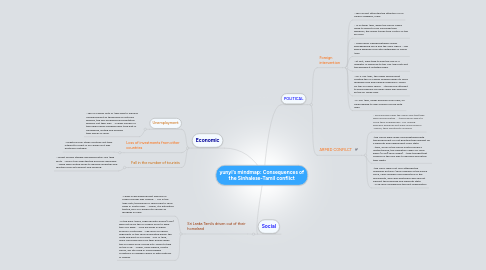
1. Social
1.1. Sri Lanka Tamils driven out of their homeland
1.1.1. ~Large-scale displacement beyond Sri Lanka"s border was caused. ~ e.g. in the 1983 riots, thousands of Tamils fled to Tamil Nadu in South India. ~Today, it is estimated that 65,000 Sri Lankans still remain as refugees in India.
1.1.2. ~In the early 1990s, High Security Zones (HSZ) were set up by the Sri Lankan Army to keep the LTTE away. ~HSZ are areas in which access is controlled. ~The army occupied large parts of the Tamil-dominated areas i the north and east of Sri Lanka. ~E.g. in 1995, many Tamil had flee from their homes when the Sri Lanka Army moved into Jaffna to take on the LTTE. ~Today, many people, mostly Tamils, are still living in overcrowded conditions in refugee camps or with relatives or friends.
2. Economic
2.1. Unemployment
2.1.1. ~The Sri Lankan riots of 1983 lead to massive Unemployment as thousands of factories workers, the self-employed and plantation workers lost their jobs. ~A large number of the jobless were Sinhalese who took part in vandalizing, looting and burning their places of work.
2.2. Loss of investments from other countries
2.2.1. ~Investors from other countries lost their interest to invest in Sri Lankan as it was politically unstable.
2.3. Fall in the number of tourists
2.3.1. ~Tourist arrivals steadily decreased after July 1983 Riots. ~This in turn affected the economy adversely. ~There were limited funds to develop amenities and facilities such as transport and housing.
3. POLITICAL
3.1. Foreign intervention
3.1.1. ~The conflict attracted the attention of Sri Lanka's neighbor, India
3.1.2. ~ In october 1987, when the Tamils Tigers failed to failed to fully surrender their weapons, the Indian troops took control of the by force
3.1.3. ~ There were clashed between Indian peacekeeping force and the Tamil Tigers. ~The peace keeping force later withdrawn in March 1990
3.1.4. ~At first, India tried to play the role of a mediator in response to the July 1983 riots but the dialogue it initiated failed.
3.1.5. ~On 3 July 1987, the Indian government violated the Sri Lankan airspace when its force dropped food and medical supplies in Jaffna for the Sri Lanka Tamils. ~Its precious attempt to send supplies via Indian ships was spurned by the Sri Lanka navy
3.1.6. ~In July 1987, under pressure from India, Sri Lanka agreed to sign a peace accord with India
3.2. ARMED CONFILCT
3.2.1. ~ policies had made the Tamils feel that they were discriminated . ~tried various ways to voice their unhappiness . e.g. making peaceful demands but were unsuccessful. ~hence, they resorted to violence
3.2.2. ~the Tamils were angry and dissatisfied with the government for not granting their request for a separate and independent Tamil state. ~thus, some of the Tamils youth formed a militant group, the Liberation Tigers Of Tamil Edam (LTTE)(Tamil Tigers). ~they thought that violence is the only way to demand and obtain their rights.
3.2.3. ~the Tamil Tigers not only attacked the Sinhalese but also /Tamil member of the police force, Tamil member and supporters of the ruling party, and Tamil politicians who did not support the proposed and separate state. ~LTTE was considered a terrorist organisation
